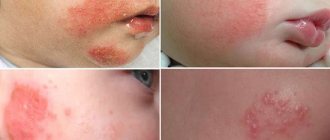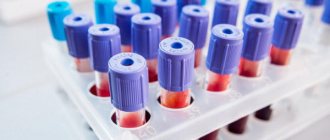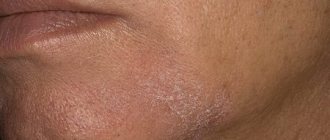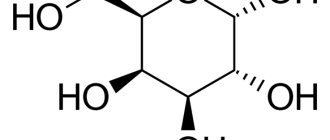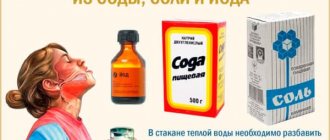July 01, 2019
Averyanova Sveta
Atopic dermatitis in children is a pressing problem for domestic and world pediatrics. The incidence has increased several times over the past 30 years. According to statistics, in developed countries, up to 15% of children aged from infants to 5 years and 20% of schoolchildren suffer from this pathology. Severe forms of the disease sharply reduce the quality of life of the child and his parents. With an adequate approach to treatment and lifestyle, it is possible to achieve complete remission.
Reasons for appearance
Atopic dermatitis is an allergic, non-contagious skin disease that appears in children with a hereditary predisposition to atopic diseases. It is characterized by a chronic relapsing course with age-related features of the location and structure of inflammatory foci, severe skin itching, which occurs when interacting with allergens or nonspecific irritants.
In most cases, the pathology first appears in the 1st year of the baby’s life. Half of the children with atopic dermatitis are subsequently diagnosed with bronchial asthma, hay fever, and allergic rhinitis.
Scientific fact! If the baby’s mother and father are healthy, then the risk of developing the disease does not exceed 20%. The presence of atopic dermatitis in one of the parents increases the likelihood of the disease to 55%, in both - up to 80% of cases.
The etiology of the disease is not fully understood . Currently, the underlying cause of the rash associated with atopic dermatitis is considered to be a deficiency or inadequate functioning of the protein responsible for the preservation of the protective layer of the skin.
This protein is called filaggrin. It prevents epidermal cells from losing water. If there is a lack of it, the skin becomes dry and its function is impaired.
Foreign agents easily penetrate through damaged skin. They cause the occurrence of inflammatory processes and sensitization of the body. The stratum corneum is destroyed. The immune system begins to perceive its own substances as foreign, which leads to atopy (from the Greek atopia - strangeness, unusualness).
The pathogenesis of the disease also depends on the activity of the nervous system. If the nerves are tense, the child experiences fear or other strong emotions, this contributes to the development of the disease.
Often mothers associate the appearance of dermatitis with the baby’s diet. If the newborn is breastfed, then the woman removes all “dangerous” foods from her diet. In older children, potential food allergens are also excluded.
However, only 30% of patients with atopic dermatitis have food allergies. In other cases, the quality of food will not be a provoking factor. Why deterioration can occur due to food, explains the famous pediatrician Komarovsky.
He says that skin inflammation is a consequence of stagnation in the intestines. The remains of undigested food rot, the breakdown products enter the bloodstream and then out with sweat, causing irritation of the sensitive surface epithelium. An excess of harmful substances in the gastrointestinal tract may be due to:
- overeating, so atopic dermatitis occurs more often in infants if they are bottle-fed;
- lack of enzymes to break down certain types of foods;
- gastrointestinal diseases (including those associated with Helicobacter pylori), dysbacteriosis;
- constipation
When you sweat excessively, harmful substances affect unprotected skin. Inflammation begins. If external irritants are added, the inflammatory reaction becomes more pronounced.
Thus, two main conditions are needed for the development of atopic dermatitis:
- the baby must have an atypical structure of the lipid layer of the skin, due to which it will be dry and unable to retain moisture (this feature can be inherited from both parents);
- The skin will be affected by various internal (decomposition products, immune cells) and external harmful factors (allergens and nonspecific irritants).
When the stratum corneum of the epidermis, which is a kind of antigen depot, is destroyed, the latter become open to cells of the immune system. Simple inflammation develops into an autoimmune process. The number of Th2 lymphocytes, cytokines IL-4, IL-5, immunoglobulins E and eosinophils increases. The formation of gamma interferon is reduced.
Food dermatitis: what is it?
Food dermatitis is a skin reaction to eating certain foods. This is a type of atopic dermatitis. Accordingly, the disease is of an allergic nature and is often based on a genetic predisposition.
Food dermatitis manifests itself as itching and rash. Like any other allergic dermatitis, the disease often causes complications in the form of bronchial asthma. An allergic reaction can occur to any product. American scientists have found that only 8 foods are responsible for 93% of allergy cases: milk, eggs, fish, crayfish, peanuts, tree nuts, soy and wheat. Children also often suffer from allergies to strawberries and tomatoes.
People of all ages are prone to foodborne dermatitis, but infants are most often affected. The disease rarely develops in adulthood. Unless a person lives next to a factory or other industrial enterprise that poisons the environment.
What does the disease look like? Symptoms
Visual manifestations of atopic dermatitis can be characterized by the following elements (photos can be found on the Internet):
- vesicle - a small bubble with a clear liquid;
- papule - a hard nodule (no more than 5 mm) rising above the surface of the skin;
- plaque - a dense node resulting from the combination of several papules, with a diameter greater than 5 mm;
- spot - a clearly defined area of skin with a changed color without sinking or elevation;
- crust - dried serous exudate, pus or blood;
- scale - thin plates of separated dead epithelium;
- erosion - a wound on the skin due to the destruction of epidermal cells;
- fissure - a skin defect with clearly demarcated walls, affecting the epidermis and dermis;
- atrophy - thinning of skin structures and (or) subcutaneous tissue;
- weeping - an accumulation of bursting bubbles that release liquid;
- lichenification - thickening and strengthening of the skin pattern.
The disease differs in the structure and localization of skin manifestations at different age periods. Itching is always observed.
The clinic is as follows:
- In infancy (2 months), the exudative form of the disease dominates. The process is acute or subacute. A two-month old baby's skin will become red, swollen, wet and crusty. Inflammation will most often begin on the face (on the forehead, cheeks) and the outer parts of the legs. The rash affects the flexor and extensor surfaces of the arms and legs. By the end of this period, the rashes are mostly located in the folds of large joints (knees, elbows) and in the wrists and neck.
- The second age stage is characterized by a decline in acute phenomena and the development of a chronic process. Irritation on the skin will mainly be observed in the folds of the elbows, under the knees, along the back of the neck, behind the ears, and in the flexion zones of the ankle and wrist joints. The skin is red, sometimes with a bluish tint, swollen, thickened, with an increased skin pattern, with numerous cracks, scratches and pigmentation.
- In adolescence, signs of papular infiltration with lichenification predominate. The rash most often affects the upper half of the torso, face, neck and upper limbs.
With a limited process, the rash will affect no more than two areas (less than 10% of the total skin area). For example, when irritated by cold air, the hands and cheeks will be affected. If you come into contact with a wool scarf, a rash will appear on your chin or near your mouth. If a child wears the wrong shoes, changes will appear on the feet.
With widespread damage, the skin of the back, chest and neck is partially involved in the process. Lesions can be observed on the head, shoulders, thighs, forearms and legs. The area of inflammation ranges from 10 to 50% of the skin.
Diffuse eczema affects more than 50% of the epidermis. The lesions can be localized in typical and atypical places for the disease (groin area, fingers, lips, etc.). The skin will constantly itch and cause great discomfort to the child. Severe itching will lead to scratching and infection of the wounds.
Diffuse damage can develop into erythroderma (a universal change in the entire skin) with the addition of symptoms of intoxication (fever, sleep disturbance, inflammation of the lymph nodes, etc.).
Semi-quantitative scales are used to assess the severity of the disease. A pediatrician should recognize early and late symptoms. If the rash is localized in the baby in places of contact with the diaper (rashes on the abdomen, testicles, butt, genitals, groin, upper legs), then the most likely cause is allergic contact dermatitis.
If a baby immediately after eating a new product develops rashes on the face, tummy or other part of the body, then the culprit is a food allergy. With this disease, as a rule, the rash is homogeneous, occurs quickly and goes away after the allergen is removed from the body. Atopic dermatitis can be combined with food allergies.
Localization
Children are characterized by typical localizations of the inflammatory process. Depending on age, the frequency of damage to a certain area of the body changes. Simple contact dermatitis most often develops in the following places:
- Butt, genitals and groin.
This area often becomes inflamed in infants. If only the groin area and the skin in contact with the diaper belt and fasteners are affected, then the skin reaction will be associated only with mechanical factors. In addition to friction, urine and feces can be irritating agents. Then diaper dermatitis will appear. - Finger. Inflammation of the skin is observed in children under 3 years of age. The thumb of one hand, which the child sucks, is most often affected. Secondary infection is possible.
- Lips. Cheilitis is most often diagnosed in young children and adolescents, especially during the cold season. It occurs due to frequent licking of the lips. At the same time, the lips are dry and cracked, with small scales.
- Cheeks, ears and fingers. So-called irritative dermatitis develops in babies who like to play with cold water, and older children who walk in cold, damp weather with strong winds without mittens and a warm scarf. Swelling nodules of a bluish-red hue appear on the skin. Burning and itching bother me.
- Areas of the body subject to systematic mechanical stress (neck, elbow, knee, groin, foot, etc.). The skin becomes irritated from constant friction from clothing or shoes.
- Exposed body parts. Babies easily get sunburned because their skin is not fully formed, in particular, melanocytes are not able to function like in an adult.
Important! Sunburn in childhood is a risk of developing melanoma in the future.
A child can also get thermal burns when swimming in very hot water (over 40 degrees) or accidentally coming into contact with boiling water.
Allergic contact dermatitis in infants can develop due to the use of various chemicals in everyday life, the use of hygiene products that are not suitable for children, and some external medications.
For example, if the baby is 5 months old, he should not be smeared with a cream that is intended for children over three years old.
The older the child is, the greater the influence of various exogenous (external) factors on his body. Skin allergies can appear on the foot due to wearing poor-quality shoes or on the palm when in contact with certain plants. It is possible to distinguish one or another type of dermatitis using diagnostic tests.
Diagnostics
Diagnosing and treating atopic dermatitis is the task of a pediatrician. Therefore, if you suspect the development of the disease, you should contact him. The pediatrician will conduct a comprehensive examination of the child, assess his physical and emotional status, collect anamnesis, and record the results in the medical history.
Currently, tests and laboratory changes do not detect atopic dermatitis. Therefore, a diagnosis is made based on anamnestic and objective data. What inflammation on the skin looks like will depend on the stage of the disease, the severity of the process and the age of the child.
The diagnostic criteria proposed in 2003 by American dermatologists are as follows:
The main ones (always present):
- itching;
- inflammation of the skin (eczema) with a characteristic appearance and typical location;
- chronic relapsing course.
Minor (present in most patients):
- initial manifestations at an early age;
- the presence of atopy in close relatives;
- determination of specific immunoglobulins of class E (At);
- xerosis (dry skin).
Additional (non-specific):
- pronounced lines and increased pattern on the palms (atopic palms);
- persistent white dermographism (white stripes on the body);
- changes in the eyes (atopic face): increased pigmentation of the skin around the eyes, on the eyelids and an additional fold of the lower eyelid; recurring conjunctivitis; keratoconus (dystrophic change in the cornea, as a result of which it takes the shape of a cone);
- nipple eczema;
- lichenification (thickened areas of the skin with increased pattern and color);
- immediate reactions during testing.
Typically, the clinical picture will differ markedly from food allergies and other diseases characterized by skin manifestations. However, if necessary, differential diagnosis with diathesis, scabies, seborrheic dermatitis, allergic contact dermatitis, ichthyosis, psoriasis, skin lymphoma, chickenpox, etc. will be performed.
Additional diagnostic methods and doctors of narrow specialties will help to distinguish one pathology from another. In some cases, consultations will be needed:
- allergist;
- dermatologist;
- gastroenterologist;
- nutritionist;
- neurologist;
- otolaryngologist;
- medical psychologist.
For example, an allergist will identify allergens by applying them to the skin, a nutritionist will create an optimal menu, an ENT doctor will identify foci of chronic infection, etc.
Allergic reaction to mold
Mold is a strong allergen that can provoke hyperreactivity reactions not only in adults, but also in children. If the baby is constantly in damp conditions, then favorable conditions are created for the development of mold fungi. This leads to sensitization of the body, and subsequently to the appearance of dermatitis and other allergic diseases. As a rule, mold causes atopic dermatitis.
The difficulty lies in the fact that it is not always possible to immediately identify the cause of this condition. And the danger of an allergic reaction to mold is that in the future the child may develop allergic rhinitis, bronchitis or bronchial asthma.
Classification and types
Doctors use the classification adopted in 2002 by the Russian Association of Allergists and Clinical Immunologists. The following types of disease are distinguished:
Clinical and morphological varieties:
- exudative;
- erymatous-squamous;
- erymatous-squamous with lichenification;
- lichenoid;
Severity:
- light;
- average;
- heavy;
Process stages:
- acute;
- subacute;
- chronic, with relapses;
Prevalence of changes:
- Limited;
- Common;
- Diffuse;
Periods of illness associated with age:
- infant (1 month - 2 years);
- children (from 2 to 13 years);
- teenage (over 13 years old);
Clinical and etiological types (presence of sensitization):
- food;
- domestic;
- pollen;
- fungal.
After making a diagnosis, according to this classification, the doctor chooses treatment tactics. It will largely depend on the stage of the disease.
Treatment
It is impossible to treat atopic dermatitis without the use of local corticosteroids and emollients. The latter need to be smeared on the skin every day; the hormones are designed to fight the symptoms. They can be used for several days or for a long time until the unpleasant signs of the disease begin to disappear.
The list of hormonal drugs is huge (Akriderm (betamethasone), Elokom (mometasone), etc.). Hormones are divided into 7 classes. They vary in strength and range of side effects. The weakest and safest include: methylprednisolone aceponate (Comfoderm K, Advantan) and hydrocortisone acetate 1%.
Instructions for using GCS are as follows:
- the pediatrician selects medications, prescribes a regimen, and sets the timing of therapy;
- if you can completely remove symptoms with weak means, you should not use stronger ones;
- Do not apply strong hormones to the face and neck;
- If any side effects occur, you should consult your doctor.
In addition to hormonal medications, symptomatic treatment is prescribed:
- to overcome local symptoms (reduce itching, relieve inflammation and pain) - non-hormonal, regenerating, anti-inflammatory ointments (sulfur ointment, Panthenol, papaverine ointment, lanolin-based creams, Chlorophyllipt, zinc paste, Tsindol (zinc mash) , “Elidel”, “Emolium”, “Bepanten”, “Bioderma” line, etc.);
- to cleanse the body - sorbents: Enterosgel, activated carbon, Smecta, Polysorb and analogues;
- to restore intestinal microflora - “Acipol”, “Bifidumbacterin”, “Biovestin”, “Bifiform”;
- to improve digestion - enzyme preparation "Creon";
- to relieve itching - antihistamines: Zyrtec or Zodak drops, Ketotifen syrup, Fenistil, etc.);
- for calcium deficiency - calcium gluconate (crush the tablet, drink up to three times a day);
- for secondary infection - antiseptics: Miramistin and Fukortsin, local agents: Levomekol, Pimafukort, Fucicort, Zinocap, systemic antibiotics and antifungal drugs;
- UV therapy.
The positive effect of homeopathy and the use of Bioptron has not been scientifically proven. The use of alternative treatments must be approved by a doctor. Treatment by homeopaths and psychosomatics is not prohibited if standard therapy is carried out in parallel.
Practical advice. The choice of drugs in the pharmacy is very large. Often during treatment, medications that differ in action and composition will be used. In order not to get confused in them, you need to write down when, what product was used and what the effect was.
Treatment with folk remedies
Some parents consider traditional methods of treatment more effective. It is not forbidden to prepare herbal decoctions and take baths with sea salt or soda at home. However, alternative therapy should be recommended taking into account a number of factors and with the approval of the doctor.
The following treatment methods are considered popular and safe:
- vegetable oils (olive oil, coconut oil, sea buckthorn oil, etc.), they are applied to the skin in the absence of individual intolerance;
- herbal medicine (baths with herbs (decoction of bay leaf, string, sage, St. John's wort, calendula, chamomile, viburnum flowers and other plants), skin treatment (aloe, tar masks, crushed raw potatoes, etc.)
It should be borne in mind that celandine, tar and other natural substances can cause poisoning when used by young children. Therefore, it is necessary to strictly observe the dosage and exposure.
Consumer Reviews
Mvikki (irecommend.ru)
“I think it will be good for summer. I have already written about skin creams several times. Here you can read about some that I have personally used.
Let me remind you that my skin is dry, especially in winter. I use creams and body lotion every other day, immediately after the shower, while the skin is steamed. La Cree purchased this product while she was in Siberia. Since winter came out of the blue in October, my skin began to flake and itch terribly. I had to somehow save myself from these feelings. La Cree was recommended to me by a pharmacist. Made in Russia and can be used from 0 years old, that is, from birth. According to the manufacturer, the emulsion should moisturize, nourish, soothe the skin and relieve itching and irritation. This is what the packaging looks like
Everything is done in rather calm colors, the price tag has been preserved. Volume 200 ml. The composition contains extracts of string, licorice, walnut; bisabolol and violet extract; d-panthenol and sodium hyaluronate; jojoba oil.
Directions for use: Apply to skin 1-2 times a day. For very dry skin, apply as needed. Apparently I’m just in that category where I need to apply the emulsion often, since the effect was not enough for a long time. The bottle, if you can call it that, is made of plastic and is shaped like a shampoo container. Doesn't slip in your hands. The emulsion is white, light texture, herbal smell.
After application it is absorbed very quickly, there is no feeling of film or greasy shine. As I wrote above, I apply the emulsion immediately after a shower, this is what I did when I was in Siberia. But literally after a couple of hours the skin was again tight and unpleasantly peeling. I was disappointed, I wanted to rate the product 2. Then I ended up in Central Russia and applied it here, and I was very surprised that I could walk calmly for a day without any unpleasant skin sensations. I don’t know why everything is so different, maybe it’s the climate or the water is different. I think this emulsion will be ideal for normal skin prone to dryness, but for very dry skin it is better to put it aside for the summer. Thank you for your attention".
tararkova (irecommend.ru)
“A magical emulsion for your skin. Good day everyone.
During the period of breastfeeding, I developed an allergy, which was accompanied by itching and flaking of the skin, and since most medications were prohibited, the dermatologist recommended several moisturizers to choose from, from which I chose La-Cri Emulsion. I have never met this company, and most likely would not have paid attention to it if not for chance.
The emulsion is white, a little runny, every time I use it, more product comes out than needed, so its dispenser is not convenient. Its aroma is not very pleasant, but not annoying.
At first I applied this Emulsion only to areas with allergies, and then I began to apply it to my face, since with its help I got rid of the symptoms of the disease in just a few days. This emulsion perfectly moisturizes and nourishes, relieves itching and irritation. There were no negative consequences after it. I recommend this Emulsion, I give it 5 stars, despite the inconvenient dispenser.”
Sources:
- B.A. Shamov, I.G. Safiullina, A.B. Beshimova, T.B. Shamov, Differential diagnosis of atopic dermatitis, journal of Practical Medicine, 2011 https://cyberleninka.ru/article/v/differentsialnaya-diagnostika-atopicheskogo-dermatita
- Fokina R.A., Atopic dermatitis: stages of development of classification forms, Siberian Medical Journal, 2007 https://cyberleninka.ru/article/v/atopicheskiy-dermatit-etapy-razvitiya-klassifikatsionnyh-form
- Smirnova G.I. Atopic dermatitis and skin infections in children, Russian pediatric journal, 2014 https://cyberleninka.ru/article/v/atopicheskiy-dermatit-i-infektsii-kozhi-u-detey
Photos of dermatitis
Diet
According to the latest trends, foreign pediatricians and Dr. Evgeniy Olegovich Komarovsky advise a regular diet for children with atopic dermatitis, that is, introduce complementary foods, give food and prepare food according to general rules. If the infant is breastfeeding (breastfeeding), then the mother’s menu should also be complete and balanced.
Important! Natural feeding is best done for at least 6 months. Mother's milk is the most suitable and safe food for the baby.
Atopic dermatitis occurs due to allergies to specific foods in only 30% of children. To find out if a child has an undesirable reaction, you need to keep a food diary. In it, the mother writes how much milk or formula the baby eats, the start of complementary feeding, notes each new dish and the reaction to it.
If, for example, after breakfast a rash appears on the baby’s skin, a tick is placed in the diary. How to understand what exactly caused the allergy if a child has eaten several new foods - you need to give them to him again, but separately, and look at the reaction. Then write down your observations: symptoms, how quickly the rash goes away, etc.
Dr. Komarovsky emphasizes:
- if there is an allergy to a specific product, it will always be observed;
- the role of the allergen must be proven (allergological examination, medical history);
- It is not recommended to exclude the allergen completely from the menu; you just need to minimize the amount of its consumption (find a safe dose);
- the duration of exclusion of the allergenic product is calculated individually (at least 6–12 months), then it is tried again;
- children under one year old are simply not able to process some substances, so you need to follow the rule - select dishes that are appropriate for their age so that they do not cause a negative reaction in the body;
- You need to feed the child in moderation, without overfeeding, otherwise decay products will enter the bloodstream, provoking the development of atopic dermatitis.
Thus, to parents’ questions: is it possible for atopic children to have cereals, goat’s milk, corn porridge, fruits, baked goods and any other foods, the answer will be positive.
Only if the allergenic effect of a certain food is proven, it is temporarily excluded or its consumption is reduced to a safe minimum. Thus, babies under one year of age are often allergic to cow's milk proteins (up to 89%), so they are transferred to dairy-free formulas.
In recent years, negative reactions to cereal protein (gluten) have become more common. A gluten-free diet is recommended for such children. Often, children with allergies are given a rotational diet to minimize the risk of developing an allergic reaction (certain types of foods are given every 4 days).
Important! To be healthy, grow and develop normally, a child must eat well, eat cottage cheese, kefir, meat, fish, cereals, fruits and vegetables. You can put your baby on a diet only on the recommendation of a doctor.
Care
Proper skin care is the basis for treating atopic dermatitis. It is necessary to moisturize the skin with emollients every day. If parents take proper care of their baby, the risk of exacerbations will be significantly reduced.
Emollients are fatty substances that provide hydration and softening to the skin. They are fixed on the epidermis, forming a thin film that prevents moisture loss. The requirements for these products depend on the stage of the disease and the characteristics of the skin manifestations. Doctors recommend using:
- lotions and thermal water if the skin becomes wet and there are areas of damage;
- milk, light cream for peeling (before applying, you need to carefully and gently clean the child);
- fatty ointments for severe dryness;
- mandatory bathing with special emulsions, then anointing with creams in the acute phase of the disease.
Dermatologists give the following advice:
- use lotions, milks, gels, balms during the day;
- Take baths every day before bed; if your skin is very dry, you can bathe your baby more often, with mandatory treatment with creams (filters and additives will help soften the water: a decoction of flax seeds or oatmeal);
- Use the product up to 4 times a day.
The rating of creams is constantly updated with new samples; you need to find out which one is suitable for a particular child from a doctor. The simplest and most inexpensive emollient is Vaseline (Vaseline oil). Top representatives may contain vitamin E, vitamin B3, nicotinic acid, herbal ingredients, bee products, etc.
Important! The daily routine should be drawn up taking into account the need for systematic treatment of the skin.
Preventive measures
The diet of the pregnant woman and the heredity of the child determine whether the baby will then struggle with food allergies all his life. Therefore, pregnant and breastfeeding women are not recommended to abuse products from the list of highly allergenic. It is also important to treat toxicosis and other diseases in a timely manner to prevent complications and aggressive therapy.
Allergies are a common occurrence in children whose mothers smoked during pregnancy or in the first years of the child’s life. People who were weaned too early in childhood are also at risk. Doctors recommend breastfeeding for as long as possible.
Prevention of food allergies for adults consists of limiting the consumption of food with allergens, giving up bad habits (alcohol, smoking), and strengthening the immune system. The skin of a person prone to any of the dermatitis is often damaged. Therefore, it is worth taking care of its restoration and care. To speed up skin regeneration and prevent relapse of dermatitis, doctors advise using moisturizing and wound-healing products.
Share with friends
Rate this article
Possible complications
The main complication of atopic dermatitis is secondary infection of the affected skin. The infection may be:
- bacterial (usually staphylococcus and streptococcus);
- fungal (fungi of the genus Candida, etc.);
- viral (herpetic).
The addition of a herpetic infection can occur in the form of a severe form of the disease - generalized Kaposi's eczema with possible death. This is an extremely rare pathology that requires urgent medical attention, hospitalization and competent treatment.
Important! It is much more difficult to cure complications than an uncomplicated inflammatory process, so you should not let the situation get worse and consult a doctor in a timely manner.
Prevention of atopic dermatitis in children
Antigenic loads in the form of toxicosis in pregnant women, taking medications by a pregnant woman, occupational hazards, highly allergenic food - all this can provoke an exacerbation of an allergic disease in a newborn.
Pregnant women at risk are advised to avoid contact with all types of allergens:
- food;
- professional;
- household
Prevention of allergies in infants can include natural, long-term breastfeeding, rational use of medications, and treatment of diseases of the digestive system.
Forecast
Atopic dermatitis cannot be completely cured, since it is associated with the structural inherited characteristics of the skin. Modern medicine helps overcome exacerbations of the disease and allows recovery for a long period of time. How long the remission will last and how exactly the child will live with dermatitis largely depends on the child’s parents.
The prognosis is determined by the severity of the disease, the age of the patient, the presence of complications and the prevalence of the process. In half of children, symptoms go away over time. For others, the disease becomes chronic.
In itself, childhood eczema is not life-threatening. However, it greatly affects the little patient’s lifestyle, his physical and psycho-emotional state. With proper prevention of relapses and compliance with medical recommendations, the prognosis is favorable.
Peculiarities. Is the disease contagious?
Only viral and bacterial infections can be transmitted from person to person. This is not typical for dermatitis and allergies. But a predisposition to these diseases can be inherited. When one of the parents suffers from frequent outbreaks of allergic dermatitis, doctors give a 25% chance that the disease will manifest itself in the child. If both parents are predisposed to skin diseases, the risk of passing on dermatitis to the baby increases to 75%.
The peculiarities of food dermatitis also include the risk of seasonal exacerbations of the disease. It can be provoked by the consumption of a seasonal highly allergenic product in large doses. For example, strawberries in summer or citrus fruits in winter. In spring and autumn, the immune system is usually weakened, which also gives rise to food dermatitis.
Prevention of exacerbations
The main question that faces the parents of a sick child is what to do to avoid relapses, since the disease cannot be cured forever. Rehabilitation of a child after exacerbations and their prevention is based on two main points:
- exclude contact with provoking environmental factors (animal hair, house dust, insect bites, plant pollen, etc.);
- provide daily competent skin care using special products that retain moisture on the skin.
General recommendations for patients with atopic dermatitis are as follows:
- limit as much as possible interaction with irritants that cause exacerbation of the disease;
- during an exacerbation, wear cotton socks and gloves;
- wear loose, pure cotton clothing;
- cut your nails short;
- use hypoallergenic soap, shampoo and other detergents and cosmetics with a moisturizing effect according to age;
- wash the child daily for 10 minutes in warm soft water (not higher than 37–38 degrees, optimally -33°C) without chlorine;
- for washing clothes and linen, use special children's liquid detergents (not washing powder);
- wash new items before wearing them;
- Maintain air humidity in the room above 60% and temperature no higher than 21 degrees, as heat and increased sweating may worsen the condition of the skin;
- systematically carry out wet cleaning, quartz treatment and through ventilation of the room;
- remove all dust containers, toys made of low-quality materials, woolen items, hazardous substances, etc.;
- provide the baby with adequate nutrition, regime, daily routine and life;
- prepare for walks in the fresh air (take into account the negative impact of weather conditions, select the optimal clothes for the season (spring, winter, summer), in case of severe insolation, cover the skin with sunscreen, etc.)
- cure foci of chronic infection to minimize the risk of secondary infection during relapses;
- be under medical observation by a pediatrician;
- Avoid physical and emotional stress, as exacerbations can occur due to nervousness.
Often a child experiences psychological discomfort from his illness. In kindergarten or school, peers may shun him, thinking that the rash is contagious. Emotional problems can develop into depression, which will have a bad effect on the course of the disease and the general condition of the baby. Therefore, the baby needs to be educated and provided with information about his health.
Parents of little boys and girls, as well as teenagers with atopic dermatitis, should know the general aspects of the etiology, pathogenesis and clinical picture of the disease, as well as the rules for using medications. Regardless of whether treatment is carried out on a teenager or an infant, getting rid of eczema symptoms should be under the supervision of a doctor.
Clinical researches
La-Cri creams for sensitive skin and La-Cri cream for dry skin are recommended by the St. Petersburg branch of the Union of Pediatricians of Russia.
The conducted clinical study proves the high efficiency, safety and tolerability of the product for daily skin care of children with mild and moderate forms of atopic dermatitis and during remission, accompanied by a decrease in the quality of life of patients. As a result of therapy, a decrease in the activity of the inflammatory process, a decrease in dryness, itching and flaking was noted.
Answers to frequently asked questions
— Is it possible for a child to go to the sea (swimming pool)?
At sea, the phenomena of atopic dermatitis disappear, since there is almost 100 percent humidity and the skin does not experience moisture deficiency. A child with such a diagnosis is not prohibited from vacationing at sea, provided that all precautions and adequate care are taken. Swimming in a pool with chlorinated water is not advisable.
— Is it possible to get vaccinated?
Atopic dermatitis is not an absolute contraindication for vaccination. In most cases, it is possible to administer Mantoux and standard childhood vaccinations (Pentaxim, hepatitis B, etc.), but only during a period of stable remission and with the approval of the pediatrician.
— Is it possible to do massage if you are sick?
Yes, massage can be done outside of exacerbations.
— Is the child given a disability?
Typically, children with atopic dermatitis are not given disabilities. Exceptions occur in severe cases of the disease, with diffuse skin lesions and frequent relapses and complications. This issue is resolved individually with the treating doctor and ITU experts.
Methods of therapy
To treat dermatitis caused by allergies, antihistamines are primarily prescribed.
Advice! The disease tends to progress, so you need to see a doctor immediately after the first signs appear.
In addition, it is necessary to remove from the body the dangerous allergen that entered the body with food. In order for the treatment to bring results, the patient is immediately transferred to a hypoallergenic diet. In addition, vitamin therapy is recommended. For the treatment of adult patients, the following regimen is recommended:
- conducting cleansing enemas to remove the allergen from the body;
- taking sorbents and diuretics, the purpose of prescribing these drugs is also to remove the allergen as quickly as possible;
- To strengthen the body, it is recommended to administer calcium chloride and sodium thiosulfate. The drugs are administered intravenously;
- oral antihistamines;
- in severe cases, hormonal therapy is prescribed - taking medications containing glucocorticosteroids.
If the disease was detected in the early stages, then it is sufficient to use antihistamines externally and internally. This treatment will be sufficient. In severe cases, when extensive weeping surfaces appear with signs of suppuration, more serious treatment is necessary. In addition to antihistamines, the following are prescribed:
- taking antibiotics or antifungal drugs (depending on the type of infection);
- ointments containing corticosteroids (externally).
Medicines
Drug treatment must be prescribed individually, taking into account the clinical picture. So, for mild cases of the disease, the following antihistamines are prescribed:
- Suprostin;
- Loratadine;
- Claritin, etc.
The course of taking antihistamines lasts 1-2 weeks. The duration of administration and dosage are determined individually. For external use, ointments or gels containing antihistamines are prescribed. An example of such a product is Fenistil gel. In addition, the following medications for internal use may be prescribed:
- sorbents: activated carbon, Eneterosl, etc.;
- multivitamin complexes;
- probiotics to restore intestinal microflora - Linex, Bifiform, etc.;
- Antibiotics are necessary for associated bacterial infections - Doxycycline, Summed, etc.
For topical use use:
- agents that have an anti-inflammatory effect - Apriderm, Elokom, etc.;
- ointments that accelerate the rate of regeneration - Solcoseryl, Bepanten, etc.;
- drugs containing corticosteroids - Afloderm, Elokom, etc.;
- local antiseptics - Chlorhexedine solution, Fukortsin, etc.
Homeopathy remedies
Homeopathic remedies are used as part of complex treatment; their independent use is not effective enough. Homeopaths recommend products containing extracts:
- chamomile;
- nettle;
- evening primrose.
Physiotherapy
For faster skin healing, the following physiotherapeutic procedures are recommended. The type of procedures, as well as their number, is determined by the doctor. Most often, they prescribe:
- Electrophoresis with diphenhydramine or calcium chloride. This procedure effectively relieves itching and swelling.
- Use of ultraviolet light. Dosed irradiation stimulates rapid healing of the skin.
- Applications for inflamed skin with ozokerite. The procedure moisturizes and prevents peeling.
- Electrosleep. The procedure is indicated for patients with an unstable nervous system.
